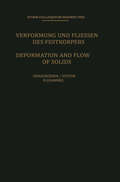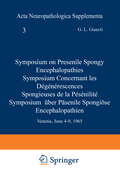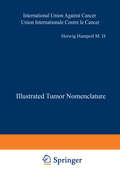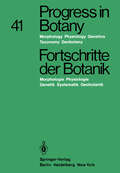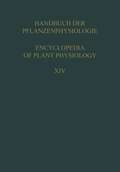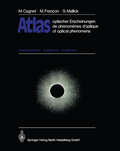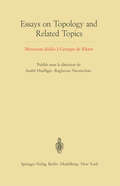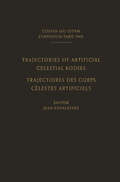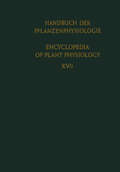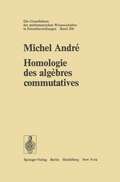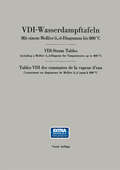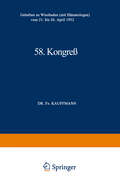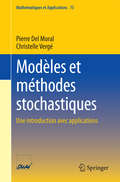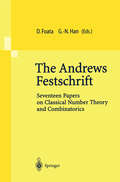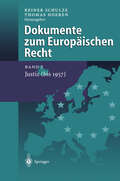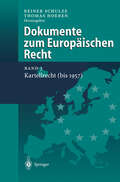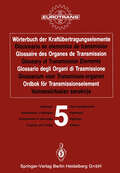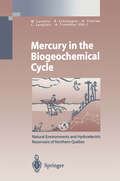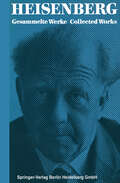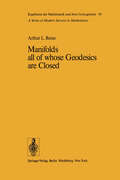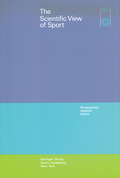- Table View
- List View
Deformation and Flow of Solids / Verformung und Fliessen des Festkörpers: Colloquium Madrid September 26–30, 1955 / Kolloquium Madrid 26. bis 30. September 1955 (IUTAM Symposia)
by Richard GrammelSymposium on Presenile Spongy Encephalopathies / Symposium Concernant les Dégénérescences Spongieuses de la Présénilité / Symposium Über Präsenile Spongiöse Encephalopathien: Venetia, June 4–9, 1965 (Acta Neuropathologica Supplementa #3)
by G. L. Guazzi F. SeitelbergerIllustrated Tumor Nomenclature: Nomenclature illustrée des Tumeurs / Иллюctpиpobahhaя homehклatypa oпyxoлeӥ / Illustrierte Tumor-Nomenklatur / Nomenclatura ilustrada de los Tumores (UICC International Union Against Cancer)
by H. Hamperl L. V. AckermanProgress in Botany / Fortschritte der Botanik: Morphology · Physiology · Genetics Taxonomy · Geobotany / Morphologie · Physiologie · Genetik Systematik · Geobotanik (Progress in Botany #41)
by Heinz Ellenberg Karl Esser Klaus Kubitzki Eberhard Schnepf Hubert ZieglerMathematical Systems Theory: Proceedings of the International Symposium Udine, Italy, June 16–27, 1975 (Lecture Notes in Economics and Mathematical Systems #131)
by G. Marchesini S. K. MitterThis volume is the record of lectures delivered at the Conference on Mathematical System Theory during the summer of 1975. The conference was held at the International Centre for Mechanical Sciences in Udine, Italy, and was supported by the Consiglio Nazionale delle Richerche of Italy and the International Centre for Mechanical Sciences. The aim of the conference was to encourage fruitful and active collaboration between researchers working in the diverse areas of system theory. It was also the hope of the organizers that mathematicians participating in the conference might become interested in the purely mathematical problems being raised by systems theory as a result of their participation. The success of the conference is to be measured by the extent to which these aims were fulfilled. Besides the formal programme of lectures recorded in this volume, many informal seminars were held. The cafes of Udine were often the scene of rich and varied discussions of recent developments in the field amongst the participants of the conference. Last but not least, listening to the ideas exposed in the lectures of others in a creative atmosphere was an important activity.
Growth and Growth Substances / Wachstum und Wuchsstoffe (Handbuch der Pflanzenphysiologie Encyclopedia of Plant Physiology #14)
by H. BurströmAtlas optischer Erscheinungen / Atlas de phénomènes d’optique / Atlas of Optical Phenomena: Ergänzungsband · Supplément · Supplement
by Michel Cagnet M. Francon S. MallickEssays on Topology and Related Topics: Memoires dédiés à Georges de Rham
by Andre Haefliger Raghavan NarasimhanTrajectories of Artificial Celestial Bodies as Determined from Observations / Trajectoires des Corps Celestes Artificiels Déterminées D’après les Observations: Proceedings of a Symposium Held in Paris, April 20–23, 1965
by J. KovalevskyIn May 1962 the International Union of Theoretical and Applied Mechanics (IUTAM) organized a symposium in Paris on the theory of the movement of the Earth's artificial satellites designated to confront the results of the first spatial experiences with the mechanical point of view. The papers submitted during this meeting have been published in 1963 in a collection entitled "Dynamics of Satellites" by Springer Verlag. During the last three years the importance of studies pertaining to the dynamics of artificial satellites has continued to increase, and many results due to observations have led to a deeper knowledge of the field of forces in which these objects move, particularly the field of gravitation of the Earth, the forces due to pressure of radiation, friction of the atmosphere, etc . . . A new symposium seemed therefore suitable to determine these recent advances. However, this time it appeared appropriate to consider it more from the point of view of the interpretation obtained from the results of observations (determination of orbits and forces existing) than from the point of view of the theory of motion. For this reason the complete title of the second symposium is as follows: "Trajectories of Artificial Celestial Bodies, as Determined from Observations".
Differenzierung und Entwicklung / Differentiation and Development (Handbuch der Pflanzenphysiologie Encyclopedia of Plant Physiology #15)
by A. LangHomologie des algebres commutatives (Grundlehren der mathematischen Wissenschaften #206)
by M. Andre(egalite 3. 4). Ce complexe T*(A,B) per met de definir les modules d'homo logie de l'algebre (definition 3. 11) Hn(A,B, W) = Yt,,[T*(A,B)@B W] et les modules de cohomologie de l'algebre (definition 3. 12) Hn(A,B, W) = Yfn[HomB(T*(A,B), W)]. En particulier l'homologie et la cohomologie d'une algebre libre sont triviales (corollaire 3. 36). Quant au module Ho(A,B,B) il est toujours isomorphe au module des differentielles de Kaehler QBIA (proposition 6. 3). Lorsque l'anneau Best un quotient de l'anneau A, la situation est simple en degre 1 (proposition 6. 1) H (A, B, W) ~ Tor}(B, W) I et en degre 2 (theoreme 15. 8, propositions 15. 9 et 15. 12) H (A,B, W) ~ Tor1(B, W)jTor}(B,B). Tor}(B, W). 2 En ajoutant des variables independantes a l'anneau A, il est d'ailleurs possible de se ramener a ce cas particulier (corollaire 5. 2). Dans cette theorie, les modules d'homologie relative sont en fait des modules d'homologie absolue. De maniere precise: a une A-algebre B et a une B-algebre C correspond une suite exacte, dite de Jacobi Zariski (theoreme 5. 1) . . . --+ Hn(A,B, W) --+ Hn(A, C, W) --+ Hn(B, C, W) -+ H _ I (A, B, W) --+ •••• n De cette suite decoulent des relations entre differentielles de Kaehler (n = 0), algebres lisses (n = 1), anneaux reguliers (n = 2) et intersections completes (n = 3). Une autre propriete fondamentale est la suivante (proposition 4.
VDI-Wasserdampftafeln / VDI-Steam Tables / Tables VDI des constantes: Mit einem Mollier (i, s)-Diagramm bis 800 °C / Including a Mollier (i, s)-Diagram for Temperatures up to 800°C / de la vapeur d’eau Comprenant un diagramme de Mollier (i, s) jusqu’à 800°C
by Werner KochMaßeinheiten, Bezeichnungen und Vereinbarungen. l In den internationalen Konferenzen über Maßeinheiten hat man sich in den letzten Jahren auf das MKS-System geeinigt mit den Grundeinheiten Meter, Kilogramm (Masse) und Sekunde. Einheit der Kraft 2 in diesem System ist die Kraft, die der Masse 1 kg die Beschleunigung 1 m/s erteilt; sie heißt Newton, ab 5 gekürzt N, es ist 1 N = 10 dyn. Einheit der Energie und damit auch der Wärmemenge ist das Newton Meter, das man mit Joule, abgekürzt J, bezeichnet, ein Joule ist gleich einer Wattsekunde. Einheit des Druckes ist das Newton je Quadratmeter. Da diese Größe recht klein ist, wird ein dezimales Vielfaches davon, 5 2 das Bar, benutzt, 10 N/m = 1 bar. Tempet"aturen werden gemessen in der Kelvinskala, definiert durch den absoluten Nullpunkt bei ° °K und den Tripelpunkt des Wassers bei 273,16 0K. Der Eispunkt, dem man bisher die Temperatur 273,16 °K zuschrieb, liegt dann bei 273,15 0K. Diese geringe Änderung von 0,01 °K gegen die frühere Festlegung ist praktisch belanglos. Die Benützung des MKS-Systems wird angestrebt, aber seine Einführung erfordert eine längere Über gangszeit, während der man auf die Kalorie und das Kraftkilogramm noch nicht wird verzichten können. Diese Einheiten verlieren aber ihre ursprüngliche Bedeutung als selbständige Grundeinheiten, sondern sie werden auf die Einheiten des MKS-Systems mit Hilfe von Umrechnungszahlen zurückgeführt.
58. Kongreß: Gehalten zu Wiesbaden (mit Hämatologen) vom 21. bis 26. April 1952 (Verhandlungen der Deutschen Gesellschaft für Innere Medizin #58)
by Professor Dr. KauffmannModèles et méthodes stochastiques: Une introduction avec applications (Mathématiques et Applications #75)
by Pierre Del Moral Christelle VergéLa théorie des probabilités et des processus stochastiques est sans aucun doute l'un des plus importants outils mathématiques des sciences modernes. Le théorie des probabilité s'illustre dans de nombreux domaines issus de la biologie, de la physique, et des sciences de l'ingénieur : dynamique des populations, traitement du signal et de l'image, chimie moléculaire, économétrie, sciences actuarielles, mathématiques financières, ainsi qu'en analyse de risque. Le but de cet ouvrage est de parcourir les principaux modèles et méthodes stochastiques de cette théorie en pleine expansion. Ce voyage ne nécessite aucun bagage spécifique sur la théorie des processus stochastiques. Les outils d'analyses nécessaires à une bonne compréhension sont donnés au fur et à mesure de leur construction, révélant ainsi leur nécessité. La théorie des processus stochastiques est une extension naturelle de la théorie de systèmes dynamiques à des phénomènes aléatoires. Elle contient des formalisation d'évolutions de phénomènes aléatoires rencontrés en physique, en biologique, en économie, ou en sciences de l'ingénieur, mais aussi des algorithmes d'exploration stochastique d'espaces de solutions complexes pour résoudre des problèmes d'estimation, d'optimisation et d'apprentissage statistique. Des techniques de résolution avancées en statistique bayésienne, en traitement du signal, en analyse d’événements rares, en combinatoire énumérative, en optimisation combinatoire, ainsi qu'en physique et chimie quantique sont exposées dans cet ouvrage. Probability theory and stochastic process theory are undoubtedly among the most important mathematic tools for the modern sciences. Probability theory has applications in several fields, such as biology, physics and the engineering sciences: population dynamics, signal and image processing, molecular chemistry, econometrics, actuarial science, financial mathematics, and risk analysis. This book provides an overview of stochastic models and methods for this very active field. Stochastic process theory is a natural extension of dynamic systems to random events. The book covers the modeling of random events in physics, biology, economics and the engineering sciences, while also introducing advanced problem-solving techniques in Bayesian statistics, signal processing and rare event analysis. No scientific background in stochastic process theory is needed.
The Andrews Festschrift: Seventeen Papers on Classical Number Theory and Combinatorics
by Dominique Foata Guo-Niu HanDokumente zum Europäischen Recht: Band 2: Justiz (bis 1957)
by S. Coßmann H. HoltmannEntwicklung und Charakter des Europäischen Gemeinschaftsrechts sind wesentlich durch die Gerichtsverfassung der Gemeinschaft und die Tätigkeit der Gerichte mitgeprägt worden. Die Vorbereitung und das Zustandekommen des Gerichtswesens und des gerichtlichen Verfahrens der Europäischen Gemeinschaft sind Gegenstand dieses zweiten Bandes der Dokumente zum Europäischen Recht, der in Aufbau und Auswahl der Dokumente der Konzeption des ersten Bandes ("Gründungsverträge") folgt. Mit der erstmals dokumentierten und editorisch aufgearbeiteten Entwicklungsgeschichte der Justiz im Europäischen Gemeinschaftsrecht bis zu den Römischen Verträgen von 1957 richtet sich dieses ergänzende Grundlagenwerk an alle, die an einer vertieften Auseinandersetzung mit den geschichtlichen Wurzeln des Gerichtswesens in Europa interessiert sind.
Dokumente zum Europäischen Recht: Band 3: Kartellrecht (bis 1957)
by Reiner Schulze Thomas HoerenDas Europäische Kartellrecht gewinnt immer mehr an Bedeutung und überlagert in vielfältiger Weise das deutsche System der Kontrolle von Marktabsprachen und Fusionen. So wichtig die Vorschriften im EG-Vertrag zum Kartellrecht sind, so wenig sind bislang deren historische Wurzeln untersucht worden. Dies hängt damit zusammen, daß die Archive der Europäischen Gemeinschaften bis 1983 nicht zugänglich waren. Erst mit der Öffnung der Archive läßt sich rekonstruieren, was sich die Väter der Verträge bei deren Abfassung in den fünfziger Jahren gedacht haben. Im vorliegenden Band werden die geschichtlichen Quellen des europäischen Kartellrechts erstmals veröffentlicht. Den verschiedenen Materialien läßt sich u.a. entnehmen, wie die unterschiedlichen nationalen Marktkonzeptionen europäisch diskutiert werden. Die Interpretation der europäischen Verträge gewinnt eine historische Dimension, aus der sich auch für das geltende Recht viele neue Aspekte ableiten lassen. Das Werk richtet sich an Europa- und Wirtschaftsjuristen in Wissenschaft und Praxis, die im Bereich des Europäischen Kartellrechts and der Frage nach dem Woher interessiert sind.
Wörterbuch der Kraftübertragungselemente / Diccionario de elementos de transmisión / Glossaire des Organes de Transmission / Glossary of Transmission Elements / Glossario degli Organi di Trasmissione / Glossarium voor Transmissie-organen / Ordbok för Transmissionselement / Voimansiirtoalan sanakirja: Band 5 · Kupplungen / Tomo 5 · Acoplamientos y embragues / Volume 5 · Accouplements et embrayages / Volume 5 · Couplings and Clutches / Volume 5 · Giunti (accoppiamenti) / Deel 5 · Koppelingen / Band 5 · Koppelingar / Osa 5 · Kytkimet
by EurotransMercury in the Biogeochemical Cycle: Natural Environments and Hydroelectric Reservoirs of Northern Québec (Canada) (Environmental Science and Engineering)
by AlainTremblay ClaudeLanglois NormandThérien RogerSchetagne MarcLucotteNowadays, major environmental issues are the object of large public debates de spite the fact that scientific knowledge is often insufficient to draw unequivocal conclusions. Such is the case in the ongoing debate regarding the specific contri butions of anthropogenic greenhouse gas emissions and of natural climate changes to global warming. At least 10 to 20 years of additional observations will be re quired, before we will be able to conclude, with certainty, on this subject. In the mean time, and as directed by their immediate interests, people will continue to promote contradictory opinions. The media are, in part, responsible for perpetuat ing such debates in that they convey indiscriminately the opinion of highly credi ble scientists as that of dogmatic researchers, the latter, unfortunately too often expressing working hypotheses as established facts. Naturally, in a similarly mis informed manner, pressure groups tend to support the researcher whose opinions most closely represent either their particular ideological battles or their economic interests and, hence, in their own way, add further to the confusion and obscurity of the debate. Only a few years ago, mercury (Hg)contamination in hydroelectric reservoirs was the object of such media and social biases. At the time, analytical data used to support the discourse were themselves uncertain and numerous hypotheses, often times fanciful, were proposed and hastily "delivered" to the public.
Scientific Review Papers, Talks, and Books Wissenschaftliche Übersichtsartikel, Vorträge und Bücher (Gesammelte Werke Collected Works #B)
by Dr. Walter Blum Professor Dr. Dürr Dr. Helmut RechenbergManifolds all of whose Geodesics are Closed (Ergebnisse der Mathematik und ihrer Grenzgebiete. 2. Folge #93)
by A. L. BesseInstability of Continuous Systems: Symposium Herrenalb (Germany) September 8–12, 1969 (IUTAM Symposia)
by Horst LeipholzUntil recently there was no uniform stability theory. Different approaches to stability problems had been developed in the different branches of mechanics. In the field of elasticity, it was mainly the so called static method and energy method which were used, while in the field of dynamics it was the kinetic method, which found its perfect expression in the theory of Liapunov. During the last few decades there has been a rapid development in the general theory of stability, stimulated, for example, by the investigations of H. ZIEGLER on elastic systems subject to non-conservative loads, and by the problems arising in aeroelasticity which are closely related to those introduced by ZIEGLER. The need was felt for kinetic methods which could also be used in investigating the stability of deformable systems. Efforts were made to adapt such methods, already known and developed in the stability theory of rigid systems, for application in the stability theory of continuous systems. During the last ten years interest was focused mainly on the application of a generalized Liapunov method to stability problems of continuous systems. All this was done in attempts to unify the various approaches to stability theory. It was with the idea of encouraging such a tendency, establishing to what extent a uniform physical and mathematical foundation already existed for stability theory in all branches of mechanics, and stimulating the further deve lopment of a common stability theory, that a IUTAM-Symposium was devoted to this topic.
The Scientific View of Sport: Perspectives, Aspects, Issues
by H. Baitsch H. E. Bock M. Bolte W. Bokler O. Grupe H. W. Heidland F. Lotzprogress and happiness - however these terms may be understood in detail - as a significant and constitutive element of scientific inquiry. In this sense the question of the way in which sport really benefits people and contributes to their happiness, and under which individual and social conditions, is a scientific question. It assumes special significance when the fact is taken into account that in the field of sport science a general scepticism is shown towards those dogmas and pedagogical theses which take such an interpretation for granted in the absence of a firm empirical foundation and a critically evolved theory. Sport and Sport Science Sport and exercise, physical culture and education in sport (physical training), gymnastics and touring combined with some form of sport are-as the present report distinctly shows-all over the world among the most striking social phenom ena of today. At first sight they seem to be uncomplicated, clear and comprehensible for everybody; they stand for a type of solidarity which is independent of differences in ideological-political outlook, and sometimes exhibit an almost archaic intensity and attraction; they are supported by the active participation or at least the interest of very many people in many parts of the world and are endued with specific func tions, varying in importance, of a medical (therapeutical, prophylactic, rehabilitative), pedagogical, psychological and social character.
